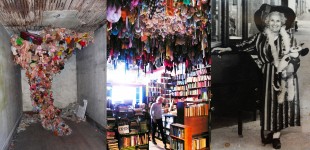…is a local arts space started over 10 years ago by George Scheer (in the buildings where his grandmother ran a thrift store for decades) which I had heard a few stories about but nothing prepared me for the inspiring visit this afternoon, encountering room after room after room after room after insane (in a good way) room of meticulously artfully thoughtfully crazily arranged thrift materials remaining from his grandmother’s store, which today functions as a community art center where artists come to town on residencies to work in a rich ecosystem of stuff – sort of encyclopedia of 20th century life – where no materials come in or out, and nothing is for sale, they have everything they need! and here is the story from the Elsewhere website…
In 1937, Joe & Sylvia Gray launched a series of businesses principled on the creative use of available surplus in downtown Greensboro. Realizing that trucks sent to New York with new furniture were returning to the region empty, they began filling them with stock from Depression-era storehouses in the North. Before long, the business known as Carolina Sales Company outgrew its space at 607 South Elm. In 1939, the Grays bought the building across the street. The space was large enough to include a first floor retail store, a second floor four-family boarding house, and a third floor warehouse. Following WWII, the furniture store gradually transitioned into an army surplus business with extensive catalog sales that sent pup tents, army bags, and canteens to Boy Scout troops and hospitals around the country. During the late 70s Sylvias inventory expanded once again to include general thrift items such as toys, books, clothing, dishes, housewares, and wigs, as well as general knick-knacks, junk, whatsamacalits, parts, pieces and particulates, bits and bobs, furniture, glass, etc ad infinitum. Over time her inventory became more or less a collection, more or less a hoard, more or less an archive that detailed her tastes, interests, and perceptions of value. Ribbons were tied around tissue boxes stuffed with toy cars. Dolls were preserved in Roman Meal bags, strung together with various other bagged collections like dresses, jewelry, plastic toys, and dried out pens. Sylvia would buy clothing items for their buttons, cut them off, and stow them in jars. She would take piles of ribbon home with her in the evening, wash them, iron them, and roll them around a pencil. Sylvia worked in the store until the day before she died. The astounding accumulation amassed over her lifetime remained in a massive heap that was boarded up after her death in 1997. In 2003, George Scheer (Sylvias grandson) and Stephanie Sherman took a spring break trip to the South with friend Josh Boyette. On a whim, the three soon to be college graduates decided to stop by Greensboro to see the old store that George had been telling them about. The objects that the young writers found sent their minds in a million directions! Sylvia’s artifacts demonstrated a potential ability to expose the kinds of ideas that form and stimulate personal connections. Of the many questions that arose from the encounter, one resonated: Could Sylvia’s collection become a thinking playground? In May 2003, George recruited two friends from Michigan, Josh Fox and Matt Merfert, to move with him to Greensboro. Declaring Nothing for Sale!, the crew of three began the long process of discovery and organization. Stephanie Sherman and Allen Davis joined them in October. A year into the excavation, Elsewhere became a 501(c)3 non-profit organization. In 2005, the group launched an artist residency program to bring global creatives across media and discipline to Greensboro in order to create new works using the collection. Thanks to a grant from the Greensboro United Arts Council, some chance movie shoots, a new-work commission (for a giant Lite-Brite!), an active crew of volunteers, and the creative inspiration of artists, Elsewhere built a sturdy foundation upon which to continue dreaming. Almost daily, Elsewherians discover new objects that reflect Sylvias fascinating mind and life. The store tells a cultural narrative about material excess, consumption, and overproduction. Our culture of constant curation allows for arrangements, artworks, and chance to layer material traces throughout the environment, re-telling a collaborative story reminiscent of the narratives shared in attics and basements across the country.

Recent Comments